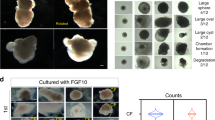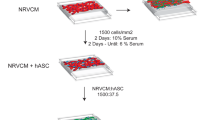Abstract
We describe here a protocol for culturing epicardial cells from adult zebrafish hearts, which have a unique regenerative capacity after injury. Briefly, zebrafish hearts first undergo ventricular amputation or sham operation. Next, the hearts are excised and explanted onto fibrin gels prepared in advance in a multiwell tissue culture plate. The procedure allows the epicardial cells to outgrow from the ventricle onto a fibrin matrix in vitro. This protocol differs from those used in other organisms by using a fibrin gel to mimic blood clots that normally form after injury and that are essential for proper cell migration. The culture procedure can be accomplished within 5 h; epicardial cells can be obtained within 24–48 h and can be maintained in culture for 5–6 d. This protocol can be used to investigate the mechanisms underlying epicardial cell migration, proliferation and epithelial-to-mesenchymal transition during heart regeneration, homeostatic cardiac growth or other physiological processes.
This is a preview of subscription content, access via your institution
Access options
Subscribe to this journal
Receive 12 print issues and online access
$259.00 per year
only $21.58 per issue
Buy this article
- Purchase on Springer Link
- Instant access to full article PDF
Prices may be subject to local taxes which are calculated during checkout





Similar content being viewed by others
References
Hu, N., Yost, H.J. & Clark, E.B. Cardiac morphology and blood pressure in the adult zebrafish. Anat. Rec. 264, 1–12 (2001).
Viragh, S. & Challice, C.E. The origin of the epicardium and the embryonic myocardial circulation in the mouse. Anat. Rec. 201, 157–168 (1981).
Sucov, H.M., Gu, Y., Thomas, S., Li, P. & Pashmforoush, M. Epicardial control of myocardial proliferation and morphogenesis. Pediatr. Cardiol. 30, 617–625 (2009).
Poss, K.D., Wilson, L.G. & Keating, M.T. Heart regeneration in zebrafish. Science 298, 2188–2190 (2002).
Raya, A. et al. Activation of Notch signaling pathway precedes heart regeneration in zebrafish. Proc. Natl. Acad. Sci. USA 100 (Suppl 1): 11889–11895 (2003).
Lepilina, A. et al. A dynamic epicardial injury response supports progenitor cell activity during zebrafish heart regeneration. Cell 127, 607–619 (2006).
Lien, C.L., Schebesta, M., Makino, S., Weber, G.J. & Keating, M.T. Gene expression analysis of zebrafish heart regeneration. PLoS Biol. 4, e260 (2006).
Wills, A.A., Holdway, J.E., Major, R.J. & Poss, K.D. Regulated addition of new myocardial and epicardial cells fosters homeostatic cardiac growth and maintenance in adult zebrafish. Development 135, 183–192 (2008).
Kim, J. et al. PDGF signaling is required for epicardial function and blood vessel formation in regenerating zebrafish hearts. Proc. Natl. Acad. Sci. USA 107, 17206–17210 (2010).
Wick, N. et al. Quantitative measurement of cell migration using time-lapse videomicroscopy and non-linear system analysis. Histochem. Cell Biol. 119, 15–20 (2003).
Pankov, R. et al. A Rac switch regulates random versus directionally persistent cell migration. J. Cell Biol. 170, 793–802 (2005).
Compton, L.A., Potash, D.A., Mundell, N.A. & Barnett, J.V. Transforming growth factor-β induces loss of epithelial character and smooth muscle cell differentiation in epicardial cells. Dev. Dyn. 235, 82–93 (2006).
Austin, A.F., Compton, L.A., Love, J.D., Brown, C.B. & Barnett, J.V. Primary and immortalized mouse epicardial cells undergo differentiation in response to TGFβ. Dev. Dyn. 237, 366–376 (2008).
Sridurongrit, S., Larsson, J., Schwartz, R., Ruiz-Lozano, P. & Kaartinen, V. Signaling via the Tgf-β type I receptor Alk5 in heart development. Dev. Biol. 322, 208–218 (2008).
Chen, T.H. et al. Epicardial induction of fetal cardiomyocyte proliferation via a retinoic acid-inducible trophic factor. Dev. Biol. 250, 198–207 (2002).
Wolberg, A.S. Thrombin generation and fibrin clot structure. Blood Rev. 21, 131–142 (2007).
Tuan, T.L., Song, A., Chang, S., Younai, S. & Nimni, M.E. In vitro fibroplasia: matrix contraction, cell growth, and collagen production of fibroblasts cultured in fibrin gels. Exp. Cell Res. 223, 127–134 (1996).
Doolittle, R.F. Fibrinogen and fibrin. Annu. Rev. Biochem. 53, 195–229 (1984).
Hamdi, H. et al. Cell delivery: intramyocardial injections or epicardial deposition? A head-to-head comparison. Ann. Thorac. Surg. 87, 1196–1203 (2009).
Smith, J.D., Melhem, M.E., Magge, K.T., Waggoner, A.S. & Campbell, P.G. Improved growth factor directed vascularization into fibrin constructs through inclusion of additional extracellular molecules. Microvasc. Res. 73, 84–94 (2007).
Itabashi, Y. et al. A new method for manufacturing cardiac cell sheets using fibrin-coated dishes and its electrophysiological studies by optical mapping. Artif. Organs 29, 95–103 (2005).
Nesbitt, T.L. et al. Coronary endothelial proliferation and morphogenesis are regulated by a VEGF-mediated pathway. Dev. Dyn. 238, 423–430 (2009).
Karuparthi, P., Nickelson, K. & Baklanov, D. Effects of endothelial growth media on proepicardial cell gene expression and morphogenesis in 3D collagen matrices. In Vitro Cell Dev. Biol. Anim. 45, 633–641 (2009).
Perner, B., Englert, C. & Bollig, F. The Wilms tumor genes wt1a and wt1b control different steps during formation of the zebrafish pronephros. Dev. Biol. 309, 87–96 (2007).
Burns, C.G. et al. High-throughput assay for small molecules that modulate zebrafish embryonic heart rate. Nat. Chem. Biol. 1, 263–264 (2005).
Lawson, N.D. & Weinstein, B.M. In vivo imaging of embryonic vascular development using transgenic zebrafish. Dev. Biol. 248, 307–318 (2002).
Brand, M., Granato, M. & Nusslein-Volhard, C. Chapter 1: keeping and raising zebrafish. in Zebrafish 12–14 (Oxford University Press, 2002).
Kikuchi, K. et al. tcf21+ epicardial cells adopt non-myocardial fates during zebrafish heart development and regeneration. Development 138, 2895–2902 (2011).
Poon, K.L., Liebling, M., Kondrychyn, I., Garcia-Lecea, M. & Korzh, V. Zebrafish cardiac enhancer trap lines: new tools for in vivo studies of cardiovascular development and disease. Dev. Dyn. 239, 914–926 (2010).
Acknowledgements
This work was supported by the American Heart Association (0730214N to C.-L.L.), National Heart, Lung, and Blood Institute Grants (R01HL096121 to C.-L.L. and R01HL096121S1 to C.-L.L. for N.R.), the Wright Foundation (to C.-L.L.), a Research Career Development Award from the Saban Research Institute (C.-L.L.), a National Institute of General Medical Sciences Grant (R01GM055081 to T.-L.T.) and California Institute for Regenerative Medicine (CIRM) postdoctoral fellowships (J.K.). We thank Q. Wu for excellent technical support, E. Fernandez for helping with taking the video and M. Chao for critically reviewing the manuscript prior to submission.
Author information
Authors and Affiliations
Contributions
J.K., T.-L.T. and C.-L.L. designed the study; J.K., N.R. and Y.H. carried out the experiments; and J.K., N.R., T.-L.T. and C.-L.L. wrote the manuscript.
Corresponding author
Ethics declarations
Competing interests
The authors declare no competing financial interests.
Supplementary information
Supplementary Video 1
Dissection of zebrafish to collect the heart for culture. (MOV 4391 kb)
Rights and permissions
About this article
Cite this article
Kim, J., Rubin, N., Huang, Y. et al. In vitro culture of epicardial cells from adult zebrafish heart on a fibrin matrix. Nat Protoc 7, 247–255 (2012). https://doi.org/10.1038/nprot.2011.440
Published:
Issue Date:
DOI: https://doi.org/10.1038/nprot.2011.440
This article is cited by
-
Hypoxia promotes a perinatal-like progenitor state in the adult murine epicardium
Scientific Reports (2022)
-
Activation of Nkx2.5 transcriptional program is required for adult myocardial repair
Nature Communications (2022)
-
Traction forces at the cytokinetic ring regulate cell division and polyploidy in the migrating zebrafish epicardium
Nature Materials (2019)
-
Explant culture of adult zebrafish hearts for epicardial regeneration studies
Nature Protocols (2016)
-
Epicardial regeneration is guided by cardiac outflow tract and Hedgehog signalling
Nature (2015)
Comments
By submitting a comment you agree to abide by our Terms and Community Guidelines. If you find something abusive or that does not comply with our terms or guidelines please flag it as inappropriate.



